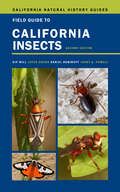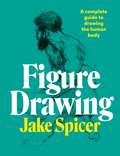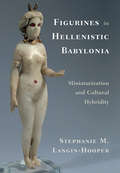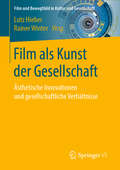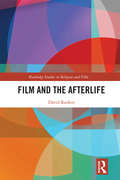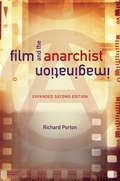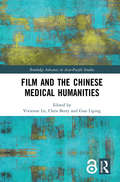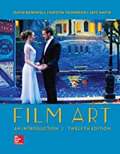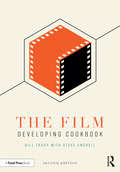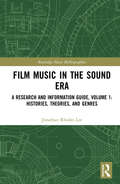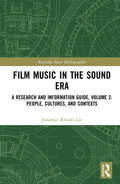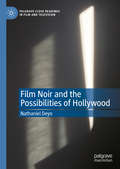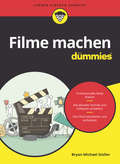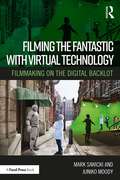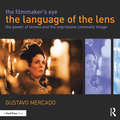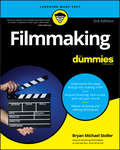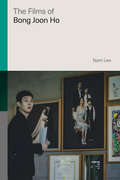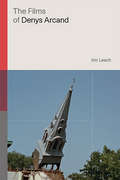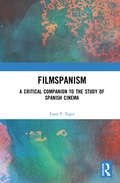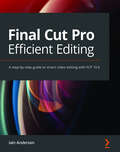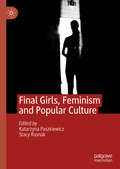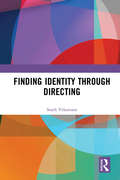- Table View
- List View
Field Guide to California Insects: Second Edition (California Natural History Guides #111)
by Kip WillBeautifully illustrated and approachable, this is the only California-specific, statewide book devoted to all groups of insects. Completely revised for the first time in over 40 years, Field Guide to California Insects now includes over 600 insect species, each beautifully illustrated with color photographs. Engaging accounts focus on distinguishing features, remarkable aspects of biology, and geographical distribution in the state. An accessible and compact introduction to identifying, understanding, and appreciating these often unfamiliar and fascinating creatures, this guide covers insects that readers are likely to encounter in homes and natural areas, cities and suburbs, rural lands and wilderness. It also addresses exotic and invasive species and their impact on native plants and animals. Field Guide to California Insects remains the definitive portable reference and a captivating read for beginners as well as avid naturalists.
Fighting in the Sky: The Story in Art
by John Fairley&“The thoughtful text and assortment of paintings illustrate just over a century of military aviation, from those early biplanes . . . to modern drones.&” —Military Model Scene Barely a decade passed from the Wright Brothers&’ first powered flight to aircraft becoming lethal instruments of war. The Royal Flying Corps and Royal Naval Air Service took off in the very early days of The Great War and captured the public&’s imagination and admiration. Sydney and Richard Carline happened to be both pilots and artists as was Frenchman Henri Farre. Their works inspired celebrated painters like Sir John Lavery who took to the skies in an airship in the First World War. Feeding on the demand for works depicting this new dimension of warfighting, a new genre of art was born which has remained popular ever since. During the Second World War, the paintings of Paul Nash stood out as did Eric Ravilious who, ironically, died in an air crash. War artist Albert Richards dropped with British paratroopers on D-Day. Post-war, paintings by leading British and international artists graphically illustrate conflicts such as the Falklands, Bosnia and the Gulf War. John Fairley has brought together a dazzling collection of art works covering over 100 years of air warfare, enhanced by lively and informative text. The result is a book that is visually and historically satisfying.&“This book is highly recommended based upon the outstanding prose, spectacular artwork, and coverage of the histories of the conflicts covered.&” —IPMS/USA&“Taken together, the paintings and descriptions present a compelling tableau of the first century of military operations in the third dimension.&” —Aviation History Magazine
Figure Drawing: A complete guide to drawing the human body
by Jake SpicerInformative and instructive, this comprehensive guide will give you all the tools you need to draw the human figure, from life and from a screen. While many books focus on just one aspect of figure drawing, this manual unites the skills of observation, expression and understanding in one coherent approach. Beginning with the key principles of observation, Figure Drawing will help you to build a strong foundation of skills to make well-observed, proportionally accurate drawings. As the book progresses you will explore processes and exercises that move beyond the purely observed to express the gesture, form and substance of your model.Photographic and illustrative examples throughout the book support your learning at every step. Clear step-by-step tutorials provide a practical understanding of the key materials, skills and ideas in figure drawing. A comprehensive anatomical reference section, broken down into manageable zones, deepens your knowledge of the human form. The book is a Swiss-bound paperback, designed to lie flat when open and in use.
Figure Drawing: A complete guide to drawing the human body
by Jake SpicerInformative and instructive, this comprehensive guide will give you all the tools you need to draw the human figure, from life and from a screen. While many books focus on just one aspect of figure drawing, this manual unites the skills of observation, expression and understanding in one coherent approach. Beginning with the key principles of observation, Figure Drawing will help you to build a strong foundation of skills to make well-observed, proportionally accurate drawings. As the book progresses you will explore processes and exercises that move beyond the purely observed to express the gesture, form and substance of your model.Photographic and illustrative examples throughout the book support your learning at every step. Clear step-by-step tutorials provide a practical understanding of the key materials, skills and ideas in figure drawing. A comprehensive anatomical reference section, broken down into manageable zones, deepens your knowledge of the human form. The book is a Swiss-bound paperback, designed to lie flat when open and in use.
Figurines in Hellenistic Babylonia: Miniaturization and Cultural Hybridity
by Stephanie M. Langin-HooperIn this volume, Stephanie M. Langin-Hooper investigates the impact of Greek art on the miniature figure sculptures produced in Babylonia after the conquests of Alexander the Great. Figurines in Hellenistic Babylonia were used as agents of social change, by visually expressing and negotiating cultural differences. The scaled-down quality of figurines encouraged both visual and tactile engagement, enabling them to effectively work as non-threatening instruments of cultural blending. Reconstructing the embodied experience of miniaturization in detailed case studies, Langin-Hooper illuminates the dynamic process of combining Greek and Babylonian sculpture forms, social customs, and viewing habits into new, hybrid works of art. Her innovative focus on figurines as instruments of both personal encounter and global cultural shifts has important implications for the study of tiny objects in art history, anthropology, classics, and other disciplines.
Film als Kunst der Gesellschaft: Ästhetische Innovationen und gesellschaftliche Verhältnisse (Film und Bewegtbild in Kultur und Gesellschaft)
by Lutz Hieber Rainer WinterDer Band beschäftigt sich mit dem Kunstbegriff im Hinblick auf Film, wobei es sowohl um ästhetische Theorie als auch um konkrete Werke geht. Das Spektrum umfasst Spielfilme und Dokumentarfilme. Dabei liegt der Schwerpunkt auf den ästhetischen Innovationen des Mediums im Laufe seiner Geschichte und in der Gegenwart. Die Entwicklung visueller Ideen wird auf den historischen und gesellschaftlichen Kontext ihrer Entstehung und Rezeption bezogen. In den Blick geraten Filmautoren, Filmkünstler und Filmbewegungen, die nicht nur im Independent-Film, sondern auch im Mainstream zu finden sind.
Film and the Afterlife (Routledge Studies in Religion and Film)
by David RankinThis book explores how post-death existence is represented in popular film, looking at issues such as continuity, personal identity, and the nature of existence beyond the grave. Film often returns to the theme of dying, death and the afterlife, both directly and indirectly, because there are very few subjects as compelling and universal. The book compares the representation of death, dying and the afterlife in films to scholarly surveys of attitudes towards life-after-death through the analysis of twenty films made between the end of World War II and now. It looks at the portrayals of stages between death and a final destination; spatio-temporal and personal continuity; the nature of afterlife existence in terms of embodiment, or not; and the contact between the worlds of the living and the dead. This book offers a wide-ranging view on a compelling subject in film. As such, it will be of great interest to scholars of Religion and Film, Religion and Media, the Philosophy of Religion, and the Sociology of Religion, as well as Religion, Media and Film Studies more generally .
Film and the Anarchist Imagination: Expanded Second Edition
by Richard PortonHailed since its initial release, Film and the Anarchist Imagination offers the authoritative account of films featuring anarchist characters and motifs. Richard Porton delves into the many ways filmmakers have portrayed anarchism’s long traditions of labor agitation and revolutionary struggle. While acknowledging cinema’s predilection for ludicrous anarchist stereotypes, he focuses on films that, wittingly or otherwise, reflect or even promote workplace resistance, anarchist pedagogy, self-emancipation, and anti-statist insurrection. Porton ranges from the silent era to the classics Zéro de Conduite and Love and Anarchy to contemporary films like The Nothing Factory while engaging the works of Jean Vigo, Jean-Luc Godard, Lina Wertmüller, Yvonne Rainer, Ken Loach, and others. For this updated second edition, Porton reflects on several new topics, including the negative portrayals of anarchism over the past twenty years and the contemporary embrace of post-anarchism.
Film and the Chinese Medical Humanities (Routledge Advances in Asia-Pacific Studies)
by Chris Berry Vivienne Lo Guo LipingFilm and the Chinese Medical Humanities is the first book to reflect on the power of film in representing medical and health discourse in China in both the past and the present, as well as in shaping its future. Drawing on both feature and documentary films from mainland China, the chapters each engage with the field of medicine through the visual arts. They cover themes such as the history of doctors and their concepts of disease and therapies, understanding the patient experience of illness and death, and establishing empathy and compassion in medical practice, as well as the HIV/AIDs epidemic during the 1980s and 90s and changing attitudes towards disability. Inherently interdisciplinary in nature, the contributors therefore provide different perspectives from the fields of history, psychiatry, film studies, anthropology, linguistics, public health and occupational therapy, as they relate to China and people who identify as Chinese. Their combined approaches are united by a passion for improving the cross-cultural understanding of the body and ultimately healthcare itself. A key resource for educators in the Medical Humanities, this book will be useful to students and scholars of Chinese Studies and Film Studies as well as global health, medical anthropology and medical history.
Film Art: An Introduction
by David Bordwell Kristin Thompson Jeff SmithFilm is an art form with a language and an aesthetic all its own. Since 1979, David Bordwell, Kristin Thompson and now, Co-Author, Jeff Smith's Film Art has been the best-selling and most widely respected introduction to the analysis of cinema. Taking a skills-centered approach supported by examples from many periods and countries, the authors help students develop a core set of analytical skills that will enrich their understanding of any film, in any genre. In-depth examples deepen students' appreciation for how creative choices by filmmakers affect what viewers experience and how they respond. Film Art is generously illustrated with more than 1,000 frame enlargements taken directly from completed films, providing concrete illustrations of key concepts. Along with updated examples and expanded coverage of digital filmmaking, the twelfth edition of Film Art delivers SmartBook, first and only adaptive reading experience currently available, designed to help students stay focused, maximize study time and retain basic concepts.
The Film Developing Cookbook
by Steve Anchell Bill TroopThe Film Developing Cookbook, 2nd edition is an up-to-date manual for photographic film development techniques. This book concentrates on films, their characteristics, and the developers each requires for maximum control of the resulting image. For two decades The Film Developing Cookbook has helped photographers acquire a working knowledge of photographic chemistry—what photo chemicals do and why—for black and white film developing. Now reissued in a revised and fully updated edition, this must-have manual for photographic film development techniques covers films, their characteristics, and the developers each require for maximum control of the resulting image. Readers will learn how to mix and use photographic solutions from scratch, and even how to create new ones. Includes invaluable information about films, developer ingredients, formulas, speed increasing, mixing and storing stock solutions, stop baths, fixers, washing, and chemical safety. A must-have for analog photography enthusiasts and any photography students using the darkroom. For in-depth discussion and questions on all things film or darkroom join the Darkroom Cookbook Forum, www.darkroomcookbook.com
Film Music in the Sound Era: A Research and Information Guide, Volume 1: Histories, Theories, and Genres (Routledge Music Bibliographies)
by Jonathan Rhodes LeeFilm Music in the Sound Era: A Research and Information Guide offers a comprehensive bibliography of scholarship on music in sound film (1927–2017). Thematically organized sections cover historical studies, studies of musicians and filmmakers, genre studies, theory and aesthetics, and other key aspects of film music studies. Broad coverage of works from around the globe, paired with robust indexes and thorough cross-referencing, make this research guide an invaluable tool for all scholars and students investigating the intersection of music and film. This guide is published in two volumes: Volume 1: Histories, Theories, and Genres covers overviews, historical surveys, theory and criticism, studies of film genres, and case studies of individual films. Volume 2: People, Cultures, and Contexts covers individual people, social and cultural studies, studies of musical genre, pedagogy, and the Industry. A complete index is included in each volume.
Film Music in the Sound Era: A Research and Information Guide, Volume 2: People, Cultures, and Contexts (Routledge Music Bibliographies)
by Jonathan Rhodes LeeFilm Music in the Sound Era: A Research and Information Guide offers a comprehensive bibliography of scholarship on music in sound film (1927–2017). Thematically organized sections cover historical studies, studies of musicians and filmmakers, genre studies, theory and aesthetics, and other key aspects of film music studies. Broad coverage of works from around the globe, paired with robust indexes and thorough cross-referencing, make this research guide an invaluable tool for all scholars and students investigating the intersection of music and film. This guide is published in two volumes: Volume 1: Histories, Theories, and Genres covers overviews, historical surveys, theory and criticism, studies of film genres, and case studies of individual films. Volume 2: People, Cultures, and Contexts covers individual people, social and cultural studies, studies of musical genre, pedagogy, and the Industry. A complete index is included in each volume.
Film Noir and the Possibilities of Hollywood (Palgrave Close Readings in Film and Television)
by Nathaniel DeyoBuilt around close readings of 11 noir films, this book seeks to refresh our understanding of “film noir” by returning to the films themselves. Pushing against totalizing or generalizing approaches, which may have the unintended effect of flattening out significant distinctions and differences between individual approaches, Film Noir and the Possibilities of Hollywood argues for the importance of staying attuned the varied and variegated formal, aesthetic and thematic strategies at work in individual films. By focusing on these strategies, the book invites readers to consider anew the enabling possibilities of Hollywood filmmaking in the studio era.
Filme machen für Dummies (Für Dummies)
by Bryan Michael StollerHeute kann jeder einen Film drehen, nur eine gute Idee braucht es dazu. Der Regisseur und Drehbuchautor Brian Michael Stoller erklärt Ihnen in diesem Buch, wie Sie ein Drehbuch schreiben und ein Storyboard entwickeln, den richtigen Drehort aussuchen, die passende Crew und Darsteller finden, den Film so drehen, dass er gut aussieht. Außerdem erläutert er, was Sie nach dem Dreh beachten sollten: Soundtrack, Special Effects und vieles mehr. Zuletzt gibt er Ihnen noch Tipps, wie Sie den Film an den Zuschauer bringen, sei es im Internet, über einen Vertrieb oder über andere Kanäle.
Filming the Fantastic with Virtual Technology: Filmmaking on the Digital Backlot
by Mark Sawicki Juniko MoodyThis book brings fantasy storytelling to a whole new level by providing an in-depth insight into the tools used for virtual reality, augmented reality, 360 cinema and motion capture in order to repurpose them to create a virtual studio for filmmaking. Gone are the long days and months of post before seeing your final product. Composites and CG characters can now be shot together as fast as a live-action show. Using off-the-shelf software and tools, authors Mark Sawicki and Juniko Moody document the set-up and production pipelines of the modern virtual/mocap studio. They reveal the procedures and secrets for making movies in virtual sets. The high-end technology that enabled the creation of films such as The Lord of the Rings, Avatar and The Jungle Book is now accessible for smaller, independent production companies. Do you want your actors to perform inside of an Unreal® Game Engine set and interact with the environment? Do you want to be able to put your live-action camera on a jib or dolly and move effortlessly through both a live-action and virtual space together? Do you want live performers interacting with giants, elves and other creatures manipulated by motion capture in real time? This book discusses all of these scenarios and more, showing readers how to create high-quality virtual content using alternative, cost-effective technology. Tutorials, case studies, and project breakdowns provide essential tips on how to avoid and overcome common pitfalls, making this book an indispensable guide for both beginners to create virtual backlot content and more advanced VFX users wanting to adopt best practices when planning and directing virtual productions with Reality™ software and performance capture equipment such as Qualysis.
The Filmmaker's Eye: The Power of Lenses and the Expressive Cinematic Image
by Gustavo MercadoThe Language of the Lens explores the expressive power of the camera lens and the storytelling contributions that this critical tool can make to a film project. This book offers a unique approach to learning how lenses can produce aesthetically and narratively compelling images in movies, through a close examination of the various ways lens techniques control the look of space, movement, focus, flares, distortion, and the "optical personality" of your story’s visual landscape. Loaded with vivid examples from commercial, independent, and world cinema, The Language of the Lens presents dozens of insightful case studies examining their conceptual, narrative, and technical approaches to reveal how master filmmakers have harnessed the power of lenses to express the entire range of emotions, themes, tone, atmosphere, subtexts, moods, and abstract concepts. The Language of the Lens provides filmmakers, at any level or experience, with a wealth of knowledge to unleash the full expressive power of any lens at their disposal, whether they are shooting with state-of-the-art cinema lenses or a smartphone, and everything in between.
Filmmaking For Dummies (For Dummies Ser.)
by Bryan Michael StollerEverything you ever wanted to know about making a movie but were afraid to ask… Lights, camera, action! We all have at least one movie in us, and the amazing and affordable advances in digital technology makes it increasingly easy to make your dream a reality and share it with the world. Filmmaking for Dummies is your definitive guide to bringing a project to life, from the comedy antics of loveable pets to the deepest, most meaningful independent film. Bryan Michael Stoller is your friend and guide, sharing his knowledge gained over 100 productions (directing and working with Dan Aykroyd, James Earl-Jones, Barbra Streisand and Drew Barrymore, among others) to show you how to take your movie from the planning and storyboarding stage, through shooting and editing, to making it available to your adoring audiences through television broadcast, streaming online or in movie theaters. For the do-it-your-selfer, the book includes tips on how to finance your project, a look at the latest software and apps, including advancements in digital technology, and for the passionate director, advice on how to hire and work with your cast and crew and find great scenic locations. Whether you want to become a professional filmmaker or just create great YouTube videos or nostalgic home movies, shooting with your smartphone or with consumer or pro-gear, this practical guide has it all. Learn how to compose your shots and when to move the camera Make the perfect pitch to sell your story Take advantage of helpful contacts and tons of new resources Get up-to-date on the latest and greatest digital technology Find the right distributor, or learn how you can be your own distributor! So, you really have no excuses to make your masterpiece. Get rolling with a copy of Filmmaking for Dummies today and start shooting for the stars!
The Films of Bong Joon Ho (Global Film Directors)
by Nam LeeBong Joon Ho won the Oscar® for Best Director for Parasite (2019), which also won Best Picture, the first foreign film to do so, and two other Academy Awards. Parasite was the first Korean film to win the Palme d’Or at Cannes. These achievements mark a new career peak for the director, who first achieved wide international acclaim with 2006’s monster movie The Host and whose forays into English-language film with Snowpiercer (2013) and Okja (2017) brought him further recognition. As this timely book reveals, even as Bong Joon Ho has emerged as an internationally known director, his films still engage with distinctly Korean social and political contexts that may elude many Western viewers. The Films of Bong Joon Ho demonstrates how he hybridizes Hollywood conventions with local realities in order to create a cinema that foregrounds the absurd cultural anomie Koreans have experienced in tandem with their rapid economic development. Film critic and scholar Nam Lee explores how Bong subverts the structures of the genres he works within, from the crime thriller to the sci-fi film, in order to be truthful to Korean realities that often deny the reassurances of the happy Hollywood ending. With detailed readings of Bong’s films from Barking Dogs Never Bite (2000) through Parasite (2019), the book will give readers a new appreciation of this world-class cinematic talent.
The Films of Denys Arcand (Global Film Directors)
by Jim LeachDenys Arcand is best known outside Canada for three films that were nominated for Academy Awards for Best Foreign-Language Film: The Decline of the American Empire (1986), Jesus of Montreal (1989), and The Barbarian Invasions (2003), the last of which won the Award. Yet Arcand has been making films since the early 1960s. When he started making films, Quebec was rapidly transforming from a relatively homogeneous community, united by its Catholic faith and French language and culture, into a more fragmented modern society. The Films of Denys Arcand sheds light on how Arcand addressed the impact of these changes from the 1960s, when the long-drawn-out debate on Quebec's possible separation from the rest of Canada began, to the present, in which the traditional cultural heritage has been further fragmented by the increasing presence of diasporic communities. His career and films offer an ideal case study for exploring the contradictions and tensions that have shaped Quebec cinema and culture in a period of increasing globalization and technological change.
Filmspanism: A Critical Companion to the Study of Spanish Cinema
by Juan F. EgeaFilmspanism explores the geopolitics of knowledge involved in academic approaches to Spanish cinema. This companion rethinks the role of disciplinarity, institutionality, and nationality in the study of film by taking into account a rather specific set of contentious issues, intellectual traditions, discursive servitudes, and invested scholarship. To that end, the book explores the topics of art cinema, popular culture, film genre, and transnationalism, always with Spanish cinema as its concrete object of study. An insightful contribution to the study of Spanish cinema, this discussion will be of interest to researchers and graduate students in Hispanic Studies and Film Studies.
Final Cut Pro Efficient Editing: A step-by-step guide to smart video editing with FCP 10.6
by Iain Anderson Yasser ShoukryA comprehensive, best practice guide from Apple Certified Trainer Iain Anderson, with illustrated step-by-step instructions to explore a Final Cut Pro editing workflow from shoot to deliveryKey FeaturesExplore the best ways to use FCP, from importing and editing to finishing and exporting the final cutUnlock the power of editing in the magnetic timeline to make huge changes or subtle adjustmentsFinish with pro-level color correction, tracking, effects, transitions, audio, titles, and captionsBook DescriptionFinal Cut Pro (also known as FCP, previously Final Cut Pro X) is Apple's efficient and accessible video editing software for everyone, offering powerful features that experienced editors and novices will find useful. FCP is the quickest way to transform your raw clips into a finished piece, so if speed is important, make this a key tool in your editing arsenal.Final Cut Pro Efficient Editing is a comprehensive best practice guide for all editors. You'll not only learn how to use the features but also find out which ones are the most important and when you should use them. With the help of practical examples, the book will show you how typical footage can be assembled, trimmed, colored, and finessed to produce a finished edit, exploring a variety of techniques. As you progress through the book, you'll follow a standard editing workflow to get the feel of working on real-world projects and answer self-assessment questions to make sure that you're on track.By the end of this Final Cut Pro book, you'll be well versed with the key features of this app and have all the tools you need to create impressive edits.What you will learnUnderstand the media import process and delve into media managementEffectively organize your footage so you can find the right shot quicklyDiscover how to assemble a rough cut editExplore trimming and advanced editing techniques to finesse and finalize the editEnhance an edit with color correction, effects, transitions, titles, captions, and much moreSweeten the audio by controlling volume, using compression, and adding effectsShare your final edited video and archive the jobWho this book is forThe book is for creative professionals, anyone starting out in video editing, and editors switching to Final Cut Pro from another video editing system. Whether you are a beginner or a professional, you'll find this FCP book useful. All you need to get started is familiarity with macOS.
Final Girls, Feminism and Popular Culture
by Katarzyna Paszkiewicz Stacy RusnakThis volume examines contemporary reformulations of the ‘Final Girl’ in film, TV, literature and comic, expanding the discussion of the trope beyond the slasher subgenre. Focusing specifically on popular texts that emerged in the 21st century, the volume asks: What is the sociocultural context that facilitated the remarkable proliferation of the Final Girls? What kinds of stories are told in these narratives and can they help us make sense of feminism? What are the roles of literature and media in the reconsiderations of Carol J. Clover’s term of thirty years ago and how does this term continue to inform our understanding of popular culture? The contributors to this collection take up these concerns from diverse perspectives and with different answers, notably spanning theories of genre, posthumanism, gender, sexuality and race, as well as audience reception and spectatorship.
The Final Years of London Midland Region Steam: A Pictorial Tribute
by David MatherExtensively illustrated with photos, a history of the many locomotives that became part of this British Railways region.This book investigates the vast number of locomotives that came to the London Midland Region in 1948 upon the nationalization of the four largest railway companies in the UK. It is a class-by-class survey with over two hundred illustrations, covering all the top link and freight classes and also looking at the smaller types of locomotive, operating on branch lines and doing more humble tasks.The author explores what happened to them, and also looks at those that eventually made their way into preservation.
Finding Identity Through Directing
by Soseh YekaniansFinding Identity through Directing is a practice-led autoethnographical monograph that provides an in-depth exploration into the field of theatre directing and an individual’s endless creative pursuit for belonging. The book specifically examines how a culturally displaced individual may find a sense of identity through their directing and addresses the internal struggles of belonging, acceptance and Self that are often experienced by those who have confronted cultural unhoming. The first half of the story scrutinises Dr Yekanians’ own identity as an Iranian born Armenian-Australian and how she struggled with belonging growing up in a world that for the most part, was unaccepting of her differences. The second half, looks at how theatre directing, aided her (re)discovery of Self. While evidence shows that within the past decade there has been a growing interest in the vocation of theatre directing, embarking on a career within this field, while exciting, can often be a daunting and experimental vocation. Finding Identity through Directing questions this conundrum and specifically asks, in a competitive artistic profession that is rapidly developing, what attracts an individual to the authoritative role of the director and what are the underlying motivations of this attraction? By uncovering that there is more to the role of the director than the mere finality of a production, we can observe that the theatre is a promising setting for cultural exchanges in dialogue and for personal development. Theatre directing as the vehicle for these expansions and progressions of self can potentially address the internal struggles of identity often experienced by those who, in some form, have encountered cultural displacement.
